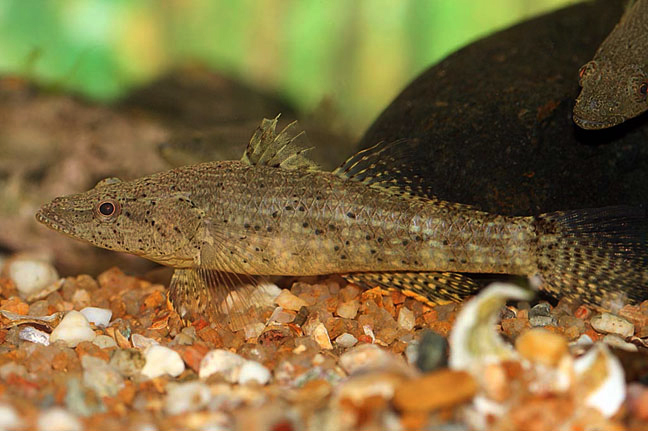Crimsontip Gudgeon, Butis butis (Hamilton-Buchanan 1822)

Crimsontip Gudgeon, Butis butis. Source: Duncan Buckle. License: All rights reserved
This ambush predator often 'stalks' its prey by hiding upside-down on sticks and floating leaves.
Video of a Crimsontip Gudgeon in Boambee Creek near Coffs Harbour, New South Wales.
High speed video of Butis butis feeding upside down.
High speed video of Butis butis feeding right side up.
Video of a Crimsontip Gudgeon in an aquarium.
Crimsontip Gudgeon, Butis butis (Hamilton-Buchanan 1822)
More Info
|
Distribution |
In northern Australia known from Port Hedland, Western Australia, to the Coffs Harbour area, New South Wales. Elsewhere, widespread in the tropical Indo-west-central Pacific, ranging from the Western Indian Ocean to the South China Sea, Australia, New Caledonia and eastwards to Fiji. Usually found on muddy bottoms in coastal marine and brackish water habitats, often amongst mangroves; also in the lower reaches of freshwater streams, preferring slower-moving waters. |
|
Features |
Meristic features: Dorsal fin VI; I, 8; Anal fin I, 8; Caudal fin (segmented rays) 15; Pectoral fin 18-21; Pelvic fin I, 5; Transverse Scales 9-10; Gill rakers 12. Body elongate, anteriorly cylindrical, posteriorly compressed, height 5-6 in SL, equal to snout and eye; caudal peduncle more than 2 times longer than high. Head pointed, depressed, 2.75-3 in SL, profile concave. Snout pointed, much longer than eye, tip before inferior part of eye, bony knob at snout tip. Eye 5-6 in head length, interorbital 1-1.5 eye diameter. Interorbital crest not denticulated, on each side two indistinct crests on snout. Lower jaw prominent, upper jaw reaching or not quite reaching to below anterior margin of eye; teeth of both jaws in many rows, outer row enlarged; inner row enlarged in lower jaw. Supraopercular groove distinct; 2-3 open pores on posterior margin of preopercle; open pore on each side in interorbital, others along each orbital crest. Body fully scaled, mostly ctenoid, those on belly, breast and pectoral fin bases cycloid; lateral line absent; longitudinal series 29-30; pre-dorsal scales about 20; finely ctenoid scales covering head and nape, except for exposed bony ridges, particularly V-shaped ridge on top of snout; ctenoid scales posteriorly on snout, between nostrils, on cheek and opercle; interoperculum naked or with few scales; ctenoid scales between eye and orbital crest; scales of head and body with auxiliary scales. Two dorsal fins, first dorsal pointed, half of body depth, second and third rays longest; second dorsal and anal fin higher than first dorsal fin, but lower than body. Pectoral fin obtuse, not shorter than head without snout. Pelvic fins separate, shorter than pectoral fin. Caudal fin obtuse, about as long as head. |
|
Size |
Reaches 14.5 cm. |
|
Colour |
Blackish to blackish brown above, often paler brown below head and on belly; sides with black lines following scale rows, and pale-brown spot in the centre of each scale; pattern on sides sometimes obscured by darker transverse blotches; distinctive dense black, sometimes double spot in centre of pectoral base, bordered above and below by bright orange-red blotches. Head with 3-5 oblique bars radiating from eyes, most prominent bar back across cheeks, another from front of eye to middle of upper jaw. Dorsal fins blackish basally and white above, first dorsal sometimes with orange to crimson margin. Anal fin similar to first dorsal, sometimes also with basal orange-red stripe. Caudal fin blackish brown with oblique white occupying dorsal margin only, or up to nearly one-third of fin; lower margin sometimes red. Pelvics blackish, with white margins. |
|
Feeding |
Carnivore - an ambush predator that feeds mostly on small fish and crustaceans. |
|
Species Citation |
Cheilodipterus butis Hamilton-Buchanan, 1822, Fishes River Ganges: 57, 367. Type locality: Ganges River, below Calcutta, India. |
|
Author |
Martin F. Gomon & Dianne J. Bray |
Crimsontip Gudgeon, Butis butis (Hamilton-Buchanan 1822)
References
Allen, G.R. 1991. Field guide to the freshwater fishes of New Guinea. Publication 9. Christensen Research Institute, Madang, Papua New Guinea. 268 pp.
Allen, G.R., Midgley, S.H. & Allen, M. 2002. Field Guide to the Freshwater Fishes of Australia. Perth : Western Australian Museum 394 pp.
Allen, G.R. & Swainston, R. 1988. The Marine Fishes of North-Western Australia. A Field Guide for Anglers and Divers. Perth : Western Australian Museum pp. 1–201 70 pls (p. 138, as B. amboinensis).
Blaber, S.J.M., J.W. Young & M.C. Dunning. 1985. Community structure and zoogeographic affinities of the coastal fishes of the Dampier region of north-western Australia. Aust. J. Mar. Freshwat. Res. 36: 247-266.
Grant, E.M. 1991. Fishes of Australia. Brisbane : E M Grant Pty Ltd 480 pp.
Hamilton-Buchanan, F. 1822. An Account of the Fishes Found in the River Ganges and its Branches. Edinburgh : Archibald Constable 405 pp. pls 1–39
Johnson, J.W. 1999. Annotated checklist of the fishes of Moreton Bay, Queensland, Australia. Memoirs of the Queensland Museum 43(2): 709-762.
Koumans, F.P. 1953. The Fishes of the Indo-Australian Archipelago. Gobioidea. Leiden : Brill Vol. 10 423 pp. 95 figs.
Larson, H. 2012. Butis butis. In: IUCN 2013. IUCN Red List of Threatened Species. Version 2013.2.
Monks, N. (ed.) 2006. Brackish-water fishes. An aquarist's guide to identification, care and husbandry. T.F.H. Publications, Inc., Neptune City, New Jersey.
Rainboth, W.J. 1996. Fishes of the Cambodian Mekong. FAO, Rome, Italy.
Ryan, P.A. 1981. Records of three freshwater fishes from the Fiji Islands. Pacific Science 35(1): 93-95.





